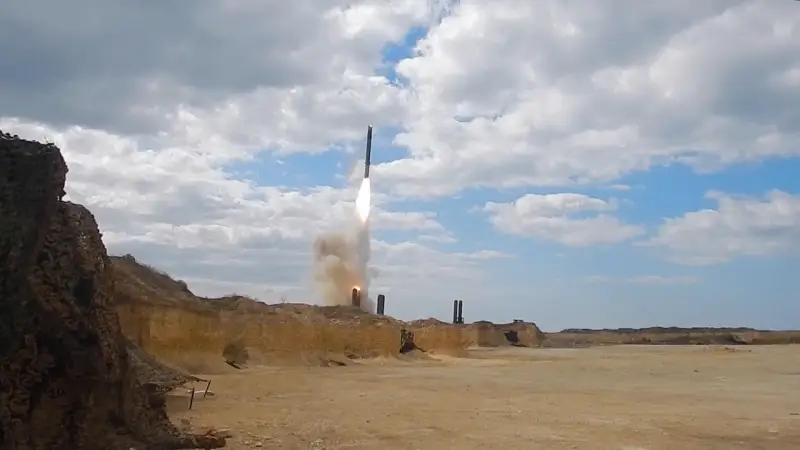Anti-ship missiles P-800 “Onyx” in Special Operations. Application experience and development paths

DBK "Bereg" launches "Onyx" missiles at targets of the Kyiv regime, March 2022. Photo of the Russian Ministry of Defense
To destroy the military infrastructure of the Kyiv regime, the Russian armed forces use various high-precision missile weapons. In particular, the Navy regularly launches Onyx guided missiles. During the current Special Operations, these products are demonstrating their capabilities beyond the original anti-ship role and effectively hitting ground targets. At the same time, experience in combat use contributes to the further development of the design and improvement of the main characteristics.
Universal weapon
P-800 / 3M55 Onyx anti-ship missiles are actively used by our troops throughout almost the entire duration of the Special Operation to protect Donbass. The first official message about the use of such a product at a Ukrainian facility appeared at the end of March 2022.
Subsequently, information about the use of P-800 missiles was regularly received through official and unofficial channels. In total, one can count dozens of such episodes with the defeat of a corresponding number of targets. However, in recent months there have been significantly fewer such messages. Apparently, the enemy has run out of targets that require supersonic anti-ship missiles to destroy.
The Ministry of Defense has repeatedly published footage of Onyx missiles being launched at enemy targets. It is curious that in all cases the firing of the 3K55 Bastion coastal missile system was demonstrated. Launches from ships of the Black Sea fleet were never shown, and there is reason to believe that they were never produced at all. Probably, the command decided to divide fire missions: the ships use Caliber cruise missiles, and Onyxes are used by coastal missile units.

Takeoff of the P-800 rocket. Photo by the Russian Ministry of Defense
Another interesting feature of using Onyx is the choice of targets for attacks. Due to the enemy’s lack of large ships, our ballistic missile systems launch missiles at stationary ground targets. Anti-ship missiles are aimed at headquarters, equipment storage and maintenance facilities, logistics infrastructure, etc. In all cases, anti-ship missiles designed to defeat more complex targets show good results.
The Kiev regime is also forced to admit the high efficiency of Onyx missiles. Thus, in July 2023, Russian anti-ship missiles once again successfully broke through the enemy’s air defenses and hit their intended targets. After this, the official representative of the Ukrainian Air Force had to make excuses for another air defense failure. He said in plain text that Ukrainian air defense systems are not able to hit Onyxes - such air targets are too complex for them.
After this, the Russian Bastions again used P-800 missiles, and again with positive results. It follows from this that all attempts by the Kyiv regime and its foreign patrons to restore and modernize Ukrainian air defense did not produce the desired results. “Onyxes” and other missile weapons continue forced demilitarization.
Ways of development
As the events of the last two years show, the Onyx high-precision missile is modern and effective weapons, capable of attacking various targets on land and water. At the same time, the missile has a certain potential for modernization and for improving all basic capabilities and characteristics. Right now the industry is tackling such problems and has already presented the first results.

The missiles are heading towards their targets. Photo by the Russian Ministry of Defense
At the end of January of this year, the general director and general designer of the military-industrial complex NPO Mashinostroeniya (Reutov, Moscow region), which produces Onyx, Alexander Leonov spoke about the current work on the development of the rocket. According to him, modernization is underway aimed at increasing the flight range. The head of the developer did not specify what this parameter would be, but noted that such growth would be significant.
Soon, domestic media learned from their sources in the defense department the possible outcome of the current project. According to them, the flight range may increase from the current 300 km to 1 thousand km. In this case, the overall potential of the rocket will increase significantly.
On March 27, the TASS agency spoke about another direction of development of the original design. Citing a source in the military-industrial complex, they write that the 3M55 missile received a new active homing head. The modernized seeker should increase the accuracy of targeting ground targets and improve the overall effectiveness of the missile.
Another TASS source reported additional modernization of the rocket's on-board electronics. These works are aimed at increasing resistance to the effects of electronic warfare. The nature of this modification is not specified, but it can be assumed that it is directly related to the use of active-passive radar seeker.

Launch of the Onyx missile from the submarine pr. 885. Photo by Sevmash PA
General perspectives
Thus, in the foreseeable future, a deeply modernized version of the P-800 product with a number of important advantages will be able to enter service with the Navy. It will be able to fly much further and more reliably capture and track a target. At the same time, the ability to work against surface and ground targets will remain, incl. covered by modern air defense systems.
During the current Special Operation, Onyx missiles are used by Bastion coastal systems. It is obvious that these ballistic missile systems will be able to use modernized long-range anti-ship missiles, perhaps after some updating of the on-board systems. It is not difficult to understand how the combat capabilities of the complexes will change, and how the missile will affect the combat effectiveness of coastal troops.
DBK 3K55 are in service with coastal units of all main fleets of the Russian Navy. Now they are capable of controlling the coastal zone at ranges of up to 300 km, and new anti-ship missiles will increase this area significantly. Accordingly, the capabilities of coastal troops to protect the coast from enemy ships will increase. In addition, it will be possible to work on more distant ground objects - as is already done during the Special Operation.
At the moment, the 3M55 product can be considered one of the main anti-ship missiles of our Navy. “Onyxes” are used with 3S-14 universal firing systems installed on several types of ships. Currently, the fleet has more than 30 potential carriers of such anti-ship missiles, and new pennants are also being built.

Flight profile of the P-800 missile in the export version of the Yakhont when launched from the carrier ship. Graphics NPO Mashinostroeniya
Onyxes are also included in the ammunition load of the multi-purpose nuclear submarines Project 885(M) Yasen. These nuclear submarines carry eight launchers, each of which can accommodate four standard-sized missiles and is compatible with P-800 products. The Navy has already received four of these ships, and six more are under construction or planned for construction.
Surface and underwater platforms make it possible to extend missile launch lines to great distances from their bases and from the shore. The area of responsibility of the Onyx complex is changing accordingly. Ships and submarines with modernized anti-ship missiles, flying 1 thousand km, will become even more effective. At the same time, they will retain the ability to use not only 3M55 missiles, but also ammunition from the Caliber complex. Depending on the characteristics of the targets and the enemy’s air defense, ships and submarines will be able to use supersonic Onyxes or slower winged Calibers, obtaining the desired effectiveness.
Useful experience
Testing and firing practice allow one to accumulate the necessary experience in operating any weapon, but it can only be fully tested in real combat operations. The Russian supersonic high-precision anti-ship missile P-800 “Onyx” was first used on a real target in 2016 – it was used to destroy a terrorist target in Syria. Since 2022, serial products of this type have been actively and regularly used to destroy objects of the Kyiv regime.
Long-term operation in the army and combat use in two operations allowed us to accumulate solid experience, as well as determine ways for further development of the existing missile. It is known about two directions of modernization of Onyx, and it cannot be ruled out that other ways to improve the rocket and increase its characteristics are being explored. However, already known modernizations can significantly increase the potential of anti-ship missiles and systems compatible with them.
Information